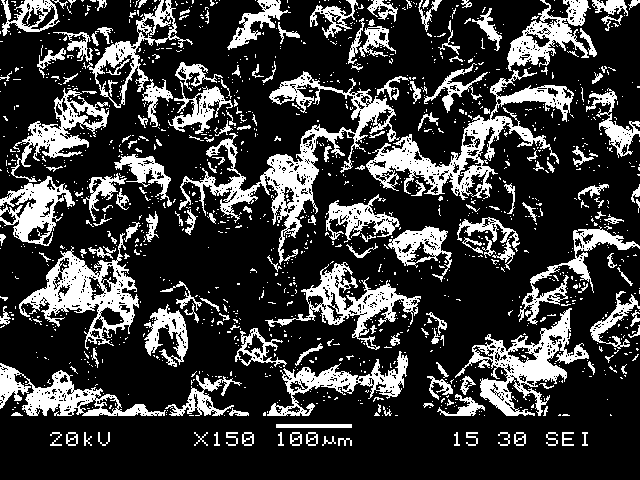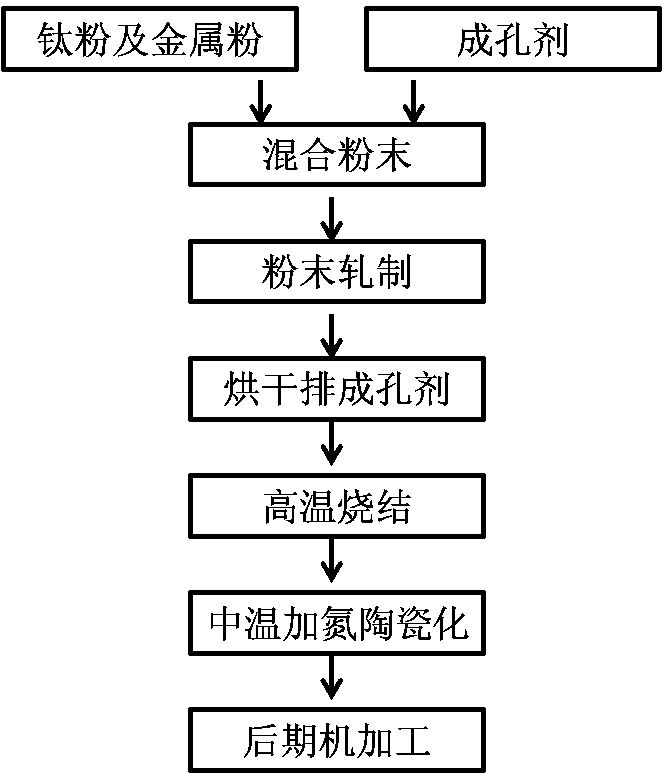Porous metal-ceramic composite material gas spreading layer used for hydrogen fuel cell and preparation method thereof
A gas diffusion layer and fuel cell technology, which is applied to fuel cell parts, battery electrodes, circuits, etc., can solve the problems of reducing gas mass transfer, affecting gas distribution, and reducing fuel cell performance, achieving uniform and effective diffusion, improving The effect of operating efficiency and excellent mechanical strength
- Summary
- Abstract
- Description
- Claims
- Application Information
AI Technical Summary
Problems solved by technology
Method used
Image
Examples
Embodiment 1
[0024] Raw materials: titanium powder, 500 mesh, purity > 99% Ti; ammonium bicarbonate powder, purity > 99%.
[0025] 1. Roughly grind the ammonium bicarbonate powder with a mortar, and process the ground powder with an ultrafine pulverizer. The obtained powder should be a 400-mesh micropowder.
[0026] 2. Mix titanium powder and ammonium bicarbonate micropowder according to the predetermined weight ratio, 2 kg of titanium powder and 500 g of ammonium bicarbonate powder in a three-dimensional mixer, and the mixing time is 30-45 minutes.
[0027] 3. Pass the mixed powder of the obtained titanium powder and ammonium bicarbonate micropowder through a 60-mesh sieve to remove agglomerates.
[0028] 4. Using a powder rolling mill, adjust the distance between the rolls, and roll the sieved powder into a billet strip with a predetermined thickness of 1 mm. The transverse thickness difference is less than 0.05 mm within 20 cm, and the longitudinal thickness difference is no more t...
Embodiment 2
[0036] Raw materials: titanium powder, 500 mesh, purity > 99%; aluminum powder, 500 mesh, purity > 99%, ammonium bicarbonate powder, purity > 99%.
[0037] 1. Roughly grind the ammonium bicarbonate powder with a mortar, and process the ground powder with an ultrafine pulverizer. The obtained powder should be a 400-mesh micropowder.
[0038] 2. Mix titanium powder and ammonium bicarbonate powder according to the predetermined weight ratio, 2 kg of titanium powder, 50 grams of aluminum powder, and 800 grams of ammonium bicarbonate powder in a three-dimensional mixer, and the mixing time is 30-45 minutes.
[0039] 3. Pass the mixed powder of the obtained titanium powder and ammonium bicarbonate micropowder through a 60-mesh sieve to remove agglomerates.
[0040] 4. Use the powder rolling mill to adjust the distance between the rolls, and roll the sieved powder into a billet strip with a predetermined thickness of 0.5 mm. The transverse thickness difference is less than 0.03 mm...
PUM
| Property | Measurement | Unit |
|---|---|---|
| thickness | aaaaa | aaaaa |
| pore size | aaaaa | aaaaa |
| particle diameter | aaaaa | aaaaa |
Abstract
Description
Claims
Application Information
 Login to View More
Login to View More - R&D
- Intellectual Property
- Life Sciences
- Materials
- Tech Scout
- Unparalleled Data Quality
- Higher Quality Content
- 60% Fewer Hallucinations
Browse by: Latest US Patents, China's latest patents, Technical Efficacy Thesaurus, Application Domain, Technology Topic, Popular Technical Reports.
© 2025 PatSnap. All rights reserved.Legal|Privacy policy|Modern Slavery Act Transparency Statement|Sitemap|About US| Contact US: help@patsnap.com


